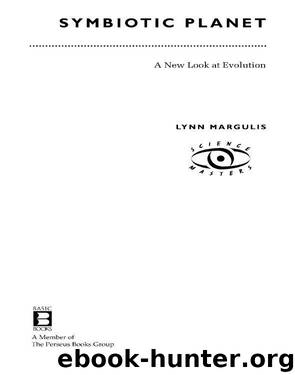Symbiotic Planet by Lynn Margulis

Author:Lynn Margulis
Language: eng
Format: epub
Publisher: Basic Books
Published: 2010-05-31T04:00:00+00:00
CHAPTER 6
SEX LEGACY
When a Lover is a Beggar
Abject is his Knee—
When a Lover is an Owner
Different is he—(1314)
Sex is tricky. The essence of sex throughout life’s evolution is the coming together of complementary gendered cells in fleeting or prolonged union. The core of sex, biologically, is gender attraction strong enough to lead to recombination of genes inside mated cells. New live beings emerge that differ in their genetic constitution from the gendered cells that met and recombined. Half their genes come from the egg, half from the sperm cell in animal-style sex.
Bacteria pass their genes with abandon as one bacterium donates its genes to another. No fifty-fifty contribution exists for bacteria. Bacteria literally pick up genes, usually a few at a time. The donor may mate when “he” physically contacts “her,” a live bacterial recipient. “She” looks just like “him.” Or gene uptake may be casual necrophilia; the recipient may just grab genes shed earlier when some dead donor left them in the water. Genes snatched from the environment may be for making vitamins, gas venting, or other traits that increase chances of survival. Sometimes the genes code for proteins that permit the recipient to detoxify life-threatening poisons. Bacterial sex is always one-sided. Genes and only genes may pass into the recipient cell from anywhere: the water, a virus, or a donor dead or alive.
Human sex, like that of all animals, is a shockingly different process. This cell-fusion sex, called meiotic sex, is the same in animals and plants. Meiotic sex is not optional. Plants and animals do not “drink” genes from DNA-rich waters. Rather, sperm cells from the male parent are attracted to egg cells from the female and fusion ensues. In fertilization an act of embryo development is induced. A new single cell, the fertile egg, the zygote, whether animal or plant, now has two sets of chromosomes, whereas the original egg and sperm had only one. The fertilized egg then grows by division of its doubled cells. One divides into two, two into four, four into eight, and so on. The cells all stick together as together they form the embryo. The fertile egg becomes a recognizable member of its species. The new tadpole, moss stalk, seed plant, reptile, screaming infant, or other youthful multicellular being that develops from the embryo is living proof that animals and plants are more closely related to one another than they are to the rest of life. The sex lives of all the many beings that never form embryos differ profoundly from those of plants and animals. Bacteria and microbial descendants of their symbiogenesis (protoctists and fungi) have other sexual habits.
When bacteria wildly reproduce they need no sex to do it. The bacterial sex that responds to certain environmental contingencies is occasional. The sex lives of plants and animals, by contrast, are absolutely required for embryo making. Without sex the life history of animals and plants does not unfold. At the beginning of the life cycle of plants and animals the sperm nucleus permanently fuses with that of the egg.
Download
This site does not store any files on its server. We only index and link to content provided by other sites. Please contact the content providers to delete copyright contents if any and email us, we'll remove relevant links or contents immediately.
Sapiens: A Brief History of Humankind by Yuval Noah Harari(14163)
Sapiens by Yuval Noah Harari(5263)
Pale Blue Dot by Carl Sagan(4856)
Homo Deus: A Brief History of Tomorrow by Yuval Noah Harari(4776)
Livewired by David Eagleman(3623)
Origin Story: A Big History of Everything by David Christian(3589)
Brief Answers to the Big Questions by Stephen Hawking(3319)
Inferior by Angela Saini(3209)
Origin Story by David Christian(3116)
The Gene: An Intimate History by Siddhartha Mukherjee(3014)
Signature in the Cell: DNA and the Evidence for Intelligent Design by Stephen C. Meyer(2996)
The Evolution of Beauty by Richard O. Prum(2912)
Aliens by Jim Al-Khalili(2763)
How The Mind Works by Steven Pinker(2695)
A Short History of Nearly Everything by Bryson Bill(2578)
Sex at Dawn: The Prehistoric Origins of Modern Sexuality by Ryan Christopher(2440)
From Bacteria to Bach and Back by Daniel C. Dennett(2423)
Endless Forms Most Beautiful by Sean B. Carroll(2402)
Who We Are and How We Got Here by David Reich(2375)
